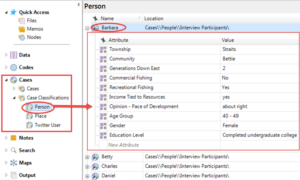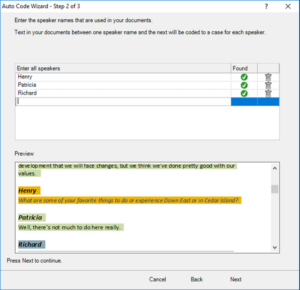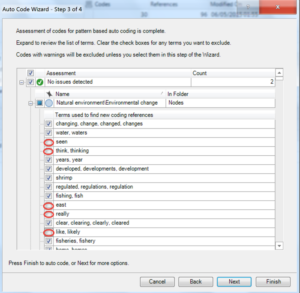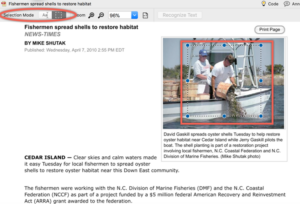
The new NVivo 12 is here, and I’m very excited to share with you all the new features and improvements that are available across both Windows and Mac, that will enhance your research experience and allow you to do more of what you want to do with NVivo.
We’ve heard your feedback about particular aspects of the software, and our developers have worked hard to bring you a new version of NVivo that we think you are really going to enjoy using more than ever before.
In this blog, I’m going to take you through a comprehensive overview of the changes in NVivo 12, across both Windows and Mac, and how these changes and new features will be of use to you in your work.
Easier to learn, faster to use
Improved navigation with a new ribbon
In NVivo 12 (Windows), we have redesigned the ribbon to make commonly used features easier to find.
Commands on the main tabs have been reorganized and many ribbon tabs are hidden until you need to work with them, reducing clutter, and giving you the tools you need, when you need them.
What’s new in terminology for both Windows and Mac?
Based on feedback from our users, we’ve updated our terminology and streamlined NVivo’s Navigation View so you can spend less time learning software, and more time working on your project.
- 'Data' is the new term to describe the source materials that you work with in NVivo
- 'Files' is the new term for the documents, PDFs, datasets, video or audio that you import into NVivo
- 'Codes' is an umbrella term for theme, sentiment and relationship nodes
Find what you’re looking for with the enhanced Navigation View
The new Navigation View reflects the new terminology and provides faster access to your data.
In NVivo 12 (Windows), the Find Bar has also been upgraded, and it will now return live search results as you type.
Enhanced support for mixed methods research
We know there are a growing number of researchers working in mixed methods and in order to support those working with both qualitative and quantitative data, we’ve added features to support this approach.
Crosstab query
The new crosstab query enables the analysis of themes by one or two attributes, such as age and gender, or by cases. Totals are automatically calculated.
For example, you might want to check:
- How often interview respondents refer to a particular topic or issue:
Or, you might want to compare mentions of particular themes by attributes such as gender and age groups.

Exchange data in SPSS format
For those researchers working with SPSS, you will now be able to export numerical data from NVivo into an SPSS data file (.sav).
For example, you can export a classification sheet or the results of a crosstab query to an SPSS data file. As you are able to export directly from NVivo into SPSS format, you won’t need to spend time editing the file or preparing it for import into SPSS, and you can begin your statistical analysis in SPSS straight away.
In NVivo 12 (Windows), you are also able to import files from SPSS to create classification sheets in NVivo. Then you can use the cross-tabs feature in NVivo to explore these variables with your thematic coding.
Enhanced classification system
Based on user feedback, we’ve made some changes to the classification system, making it more intuitive and easier to learn. We’ve done this by making the link between classification data and classified items more clearly represented.

You are now able to easily assign attribute values to your cases or files.
More ways to automate with auto coding by speaker
If you are working with data such as focus group transcripts, NVivo 12 (Windows) now has a much easier way to create cases for multiple speakers in a transcript:

You can enter the name of each speaker in a transcript and NVivo will:
- Search for the name at the start of each line
- Create a case for each speaker
- Automatically code the response at the case
No need to fiddle with heading styles in Word! (Unless you really want to.)
Enhanced pattern-based coding
Pattern based auto coding is a feature which has been available in previous versions of NVivo (Windows), and is a way of automatically coding content based on previous coding activity. NVivo uses a training set of nodes coded by the user to check for similarities in new data being coded. In NVivo 12 Plus, the process for pattern-based coding has been updated to provide greater transparency and give you more control over the results.
You are now able to see the words NVivo has identified as being relevant for a code so you can make decisions to include or exclude them as needed:

Additional improvements in NVivo 12 Mac
Improved project start-up time
Researchers using NVivo Mac have shared their feedback with us, and we’ve made great improvements to the project start-up time. You can now spend more time with your data and working on your project in NVivo 12 Mac.
PDF Region coding
NVivo 12 Mac now allows you to apply coding to regions of PDF documents, so you can then:
- Code them to nodes/cases
- Query PDF region and text coding
- Incorporate into visualizations

Generate new visualizations
Mac users are now able to use charts to present or explore the summary of their coding between files, nodes and cases with NVivo 12 Mac.

For the first time, you will be able to:
- Generate charts based on coding
- Format charts
- Drill down into original source content within the chart
- Export charts
Visualizations are an effective tool, particularly when it comes to presenting your research and we’re very pleased to be able to offer this functionality to those working with NVivo Mac.
Codebook exporting
For those researchers who may be working in a team, or simply want to share their research progress, or coding structure, NVivo 12 Mac now allows you to export your codebook.
This can be particularly helpful for consulting with your peers and mentors for direction in your research and analysis process, or when you’re working as part of a team and need to share the coding structure with other researchers.
As with all versions of NVivo, our primary goal has been to create an improved experience for all researchers based on the valuable feedback that you provide us with. We’re looking forward to hearing your thoughts on NVivo 12 and how it’s helping your research.
You can get started today with a free trial for NVivo 12 and explore the new features for yourself.
ABOUT THE AUTHOR

Silvana di Gregorio
Silvana is a sociologist and a methodologist specializing in qualitative data analysis. She writes and consults on social science qualitative data analysis research, particularly in the use of software to support the analysis. She is also QSR International's Director of Research.
